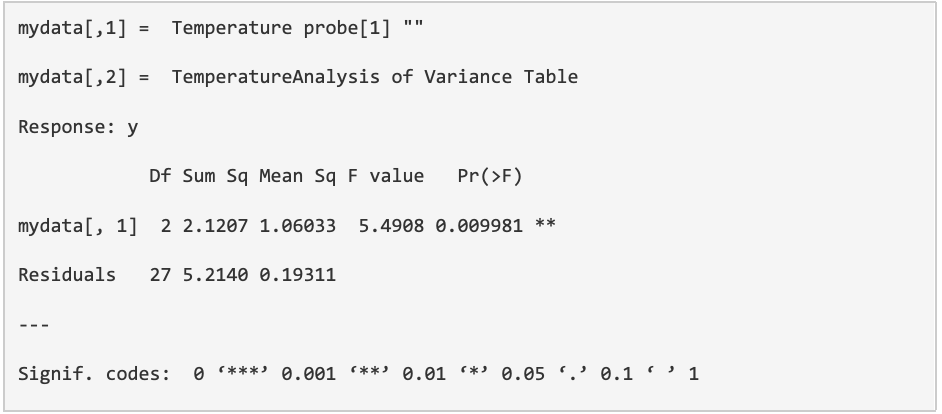
One way ANOVA
Description
Like the Student’s t-Test, the one-way ANOVA (Analysis of Variance) test measures the differences between the means of groups, however, it looks for differences between more than two groups. This test assumes that the means are calculated from normally distributed data and that the groups are independent from each other. The p-value of the test will indicate whether there are any significant differences in the mean of individual groups as a whole but to identify whether these differences exist between individual/specific pairs, a post-hoc test such as Tukey’s Honesty test is required. Under the null hypothesis that all the means are not statistically different, if rejected we can conclude there is a statistical difference between at least 2 of the means but can not conclude which 2 (or more) average means are statistically different.
Benefits
Identifies differences in continuous variables across more than two categorical groups and prevents the need to conduct multiple t-tests (which also increases type 1/α error).
Drawbacks
ANOVA will only identify the presence of significant difference between one group/pair and requires post-hoc tests to identify the specific pairs that differ. Like t-test, it also requires a continuous variable that is normally distributed.
Worked Example
Download the example Excel file below.
The example here looks for differences in the temperatures measured by temperature probes A, B and C.
- In the file there are several headed columns
- Whether the person has appendicitis or not
- Whether the temperature of the person is low, normal or high
- Open rBiostatistics >> Comparative >> Mean >> One-way ANOVA >> Analyze
- Browse and upload the Excel file
- Note that you must choose file type (.xlsx or .csv) as appropriate
- .csv files also need you to define your separator
- Select the variable you would like to include in your analysis
- Define the variables for both row and column
- Various tabs are available to view the statistical output on the top
- Error bar and Box plot are also available
- Results

- Degree of freedom (df) = 2 and 27
- Sum of squares (Sum sq) = 2.121
- Mean square (Mean Sq)= 1.060
- F-statistic (F value) = 5.491
- p-value (Pr(>F)) = 0.010
- Interpretation
- There is statistically significant differences between the probes when measuring temperature
- Example of randomised dataset
- An extra column of randomised data has been included named “random temp”
- This means it is very unlikely to generate any statistically significant findings
- By running the same steps as above using the randomised numbers, the P value will be calculated as 0.2906, which is statistically insignificant
Resources
https://people.richland.edu/james/lecture/m170/ch13-1wy.html
https://statistics.laerd.com/spss-tutorials/one-way-anova-using-spss-statistics.php
https://libguides.library.kent.edu/spss/onewayanova
https://ezspss.com/one-way-anova-in-spss-including-interpretation/
By Ka Siu Fan & Ka Hay Fan



